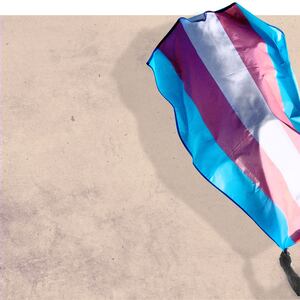A new report from the Human Rights Campaign says that over 300 transgender and gender non-conforming individuals have been killed in the United States over the last decade in what the organization calls “an epidemic of violence.”
These numbers come on the eve of Transgender Day of Remembrance, an annual community-led event where names of transgender people lost to violence in the last year are read aloud to draw attention to the violence the community faces.
Meanwhile, the HRC says that in this time the FBI has only registered 11 anti-transgender murders or negligent homicides, showing how a lack of data at the federal levels has led to severe undercounts of deadly violence against the transgender community.
ADVERTISEMENT
“Our biggest goal is to remember these people, is to make sure that their names and their stories are not lost in the fray,” Shoshana Goldberg, Director of Public Education & Research for the Human Rights Campaign Foundation told the Daily Beast.
“It's an epidemic of real people whose lives are lost, and they have friends and family members and loved ones who are mourning them. We want to make sure that they and their stories are told.”
This year, the HRC has tracked at least 32 deaths of transgender and gender non-conforming people. The number is down from last year’s total which found at least 57 trans & gender non-conforming people that were violently killed.
One single year does not provide a snapshot into the overall violence of the epidemic that transgender people face, and it is likely that more research will find a truer number to represent the violence faced this year. It is a sad reality that police and many news organizations regularly deadname—or share a transgender person’s given name rather than their chosen name—in coverage.
This makes tracking deaths harder for researchers without a central database of information. The HRC hopes that by publishing victims’ names each year shows how they were people with full lives and compels news organizations and the police to stop these practices. Of the over 300 victims, 70 percent of them were intentionally misgendered by either the police or news reports after their death.
Doing this means “we can keep the pressure on to implement the programs and policies to prevent this from happening,” Goldberg added.
The decade-long dataset showed some very clear patterns for who the victims of lethal violence against the transgender and gender non-conforming community were.
According to the data the HRC compiled, over four in five victims in the past year were people of color, and 69 percent were Black and 15 percent were Latinx.
Wynston Sanders, the Southern Equality Fund Organizer at the Campaign for Southern Equality, says that these statistics show there is a component that’s a “reflection of racism, internalized homophobia, and internalized transphobia” to why statistics paint such a bleak picture for this community.
For many Black Americans, in general, systemic violence is the norm, and “there aren’t sufficient government policies in place to assist Black people overall or trans people overall,” he added. Throw in a hostile environment for transgender people in the United States, and the problem is only exacerbated.
Another area where there is a lack of resources being directed is to addressing the emotional abuse and violence that the transgender community faces regularly.
Holistically, these gaps have been filled by groups seeking to provide mutual aid for people of color in the transgender community by groups such as House of Tulip in New Orleans, My Sistah’s House in Memphis, and Charlotte Uprising in NC. Sanders says policy makers could easily direct funds to organizations already on the ground to ultimately “lower barriers to equity for trans people of color.”
Nearly 80 percent of the victims were under the age of 35, and over two-thirds of victims were killed with a firearm. In addition, intimate partner violence accounted for nearly 20 percent of the victims and an additional 9.7 percent were killed by family members.
“Let’s look at some of the most obvious characteristics of the violence that’s happening—two-thirds of these deaths involve a firearm. Why are we not looking at gun safety and gun reform? Gun reform is definitely a trans and POC issue,” Sanders said.
“Policy makers can also better fund, support, and elevate some of the amazing organizations out there who are focusing specifically on trans people of color. In the absence of institutional help, we rely on each other for survival.”
For transgender people, currently laws on the books make navigating intimate situations tough. In 35 states, the “trans panic defense”—or the ability to claim in court that finding out the gender identity of a victim was misleading and thus the use of violence against the person was justified—is legal. According to the Movement Advancement Project, that means nearly 60 percent of Americans live in a state where this defense is valid in a court of law and could be used to sway a jury.
It’s not only these laws that have created an environment where the transgender community is at risk of violence. The HRC said that 250 anti-LGBTQ pieces of legislation were introduced in 2022, of which 24 were passed into law.
These laws provide legal discrimination against LGBTQ Americans, and many have focused on weakening protections for gender identity as a protected class. This includes the resurgence of “bathroom bills” that prevent transgender students from using bathrooms that match their gender identity, bills that criminal gender affirming medical care for transgender teenagers, and bills that prevent transgender kids from playing on sports teams that match their gender identity.
When adding in the lack of federal housing protections and job precarity that drives transgender people into dangerous situations, Goldberg said there is an “increase in the risk of experiencing fatal violence.”
Protections such as provisions in the Violence Against Women Act and the ruling of Bostock v. Clayton County has given at risk communities some mitigation against the ongoing epidemic, but more can be done she added. The HRC is continuing to press Congress to pass the Equality Act, while pushing for other protections that protect against discrimination against gender identity.
This could include making it easier for transgender people to change their legal documents to reflect their chosen names and genders to prevent authorities from misgendering them in death. Decriminalizing sex work would go a long way toward helping vulnerable members of the community that engage in this work.
Compelling federal authorities to robustly track hate crimes against the transgender community and violent deaths inflicted against transgender people would go a long way to accurately assessing the scale of this violence and call attention to the communities most affected, Goldberg added. A holistic response is thus needed by policymakers for the community’s sake and for those who have lost their lives without being recognized.
“Policy members need to change [solutions] from what we can do as individuals in our community to figuring out the ways that we want to fight back against hate and injustice in our communities,” Goldberg said. “Everyone needs to be ‘all hands on deck,’ and helping to address this and prevent it from happening again.”
The 32 known transgender and gender non-conforming people killed so far in 2022 are: Amariey Lej, Duval Princess, Cypress Ramos, Naomie Skinner, Matthew Angelo Spampinato, Paloma Vazquez, Tatiana Labelle, Kathryn “Katie” Newhouse, Kenyatta “Kesha” Webster, Miia Love Parker, Ariyanna Mitchell, Fern Feather, Ray Muscat, Nedra Sequence Morris, Chanelika Y’Ella Dior Hemingway, Sasha Mason, Brazil Johnson, Shawmaynè Giselle Marie, Kitty Monroe, Martasia Richmond, Keshia Chanel Geter, Cherry Bush, Marisela Castro, Hayden Davis, Kandii Redd, Aaron Lynch, Maddie Hofmann, Dede Ricks, Mya Allen, Acey Morrison, Semaj Billingslea, and Tiffany Banks.
The HRC also compiles a page on “Additional Concerning Deaths of Transgender and Gender Non-Conforming Individuals,” with more information about violence against the transgender community.







